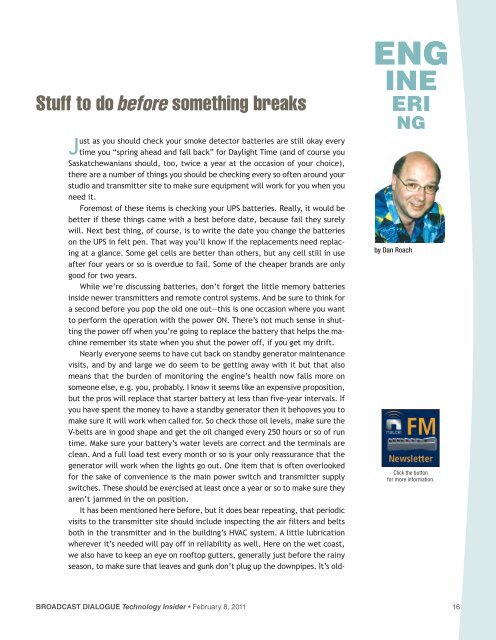Current PDF Edition - Broadcast Dialogue
Current PDF Edition - Broadcast Dialogue
Current PDF Edition - Broadcast Dialogue
Create successful ePaper yourself
Turn your PDF publications into a flip-book with our unique Google optimized e-Paper software.
Stuff to do before something breaks<br />
ENG<br />
INE<br />
ERI<br />
NG<br />
Just as you should check your smoke detector batteries are still okay every<br />
time you “spring ahead and fall back” for Daylight Time (and of course you<br />
Saskatchewanians should, too, twice a year at the occasion of your choice),<br />
there are a number of things you should be checking every so often around your<br />
studio and transmitter site to make sure equipment will work for you when you<br />
need it.<br />
Foremost of these items is checking your UPS batteries. Really, it would be<br />
better if these things came with a best before date, because fail they surely<br />
will. Next best thing, of course, is to write the date you change the batteries<br />
on the UPS in felt pen. That way you’ll know if the replacements need replacing<br />
at a glance. Some gel cells are better than others, but any cell still in use<br />
after four years or so is overdue to fail. Some of the cheaper brands are only<br />
good for two years.<br />
While we’re discussing batteries, don’t forget the little memory batteries<br />
inside newer transmitters and remote control systems. And be sure to think for<br />
a second before you pop the old one out—this is one occasion where you want<br />
to perform the operation with the power ON. There’s not much sense in shutting<br />
the power off when you’re going to replace the battery that helps the machine<br />
remember its state when you shut the power off, if you get my drift.<br />
Nearly everyone seems to have cut back on standby generator maintenance<br />
visits, and by and large we do seem to be getting away with it but that also<br />
means that the burden of monitoring the engine’s health now falls more on<br />
someone else, e.g. you, probably. I know it seems like an expensive proposition,<br />
but the pros will replace that starter battery at less than five-year intervals. If<br />
you have spent the money to have a standby generator then it behooves you to<br />
make sure it will work when called for. So check those oil levels, make sure the<br />
V-belts are in good shape and get the oil changed every 250 hours or so of run<br />
time. Make sure your battery’s water levels are correct and the terminals are<br />
clean. And a full load test every month or so is your only reassurance that the<br />
generator will work when the lights go out. One item that is often overlooked<br />
for the sake of convenience is the main power switch and transmitter supply<br />
switches. These should be exercised at least once a year or so to make sure they<br />
aren’t jammed in the on position.<br />
It has been mentioned here before, but it does bear repeating, that periodic<br />
visits to the transmitter site should include inspecting the air filters and belts<br />
both in the transmitter and in the building’s HVAC system. A little lubrication<br />
wherever it’s needed will pay off in reliability as well. Here on the wet coast,<br />
we also have to keep an eye on rooftop gutters, generally just before the rainy<br />
season, to make sure that leaves and gunk don’t plug up the downpipes. It’s oldby<br />
Dan Roach<br />
Click the button<br />
for more information.<br />
BROADCAST DIALOGUE Technology Insider • February 8, 2011 16

















